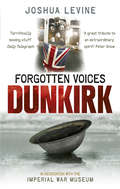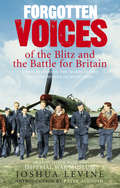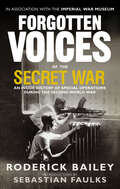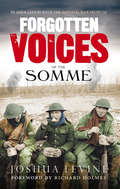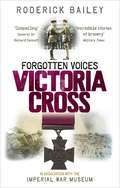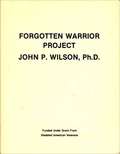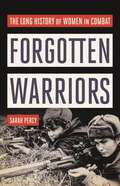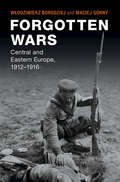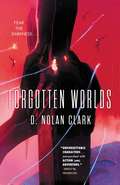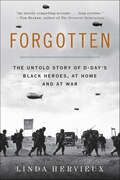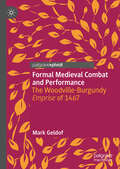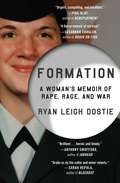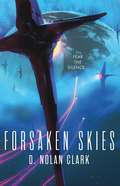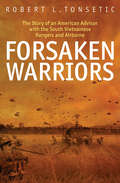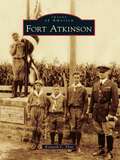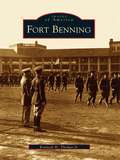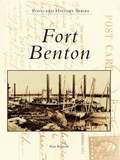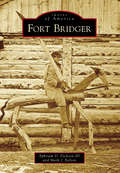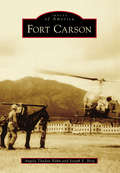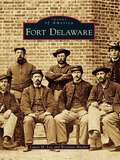- Table View
- List View
Forgotten Voices of Dunkirk
by Joshua LevineThe subject of the new major film by Christopher NolanIt could have been the biggest military disaster suffered by the British in the Second World War, but against all odds the British Army was successfully evacuated, and 'Dunkirk spirit' became synonymous with the strength of the British people in adversity.On the same day that Winston Churchill became Prime Minister, Nazi troops invaded Holland, Luxembourg and Belgium. The eight-month period of calm that had existed since the declaration of war was over. But the defences constructed by the Allies in preparation failed to repel a German army with superior tactics.The British Expeditionary Force soon found themselves in an increasingly chaotic retreat. By the end of May 1940, over 400,000 Allied troops were trapped in and around the port of Dunkirk without shelter or supplies. Hitler's army was just ten miles away. On 26 May, the British Admiralty launched Operation Dynamo. This famous rescue mission sent every available vessel - from navy destroyers and troopships to pleasure cruisers and fishing boats - over the Channel to Dunkirk. Of the 850 'Little Ships' that sailed to Dunkirk, 235 were sunk by German aircraft or mines, but over this nine day period 338,000 British and French troops were safely evacuated. Drawing on the wealth of material from the Imperial War Museum Sound Archive, Forgotten Voices of Dunkirk presents in the words of both rescued and rescuers in an intimate and dramatic account of what Winston Churchill described as a 'miracle of deliverance'.
Forgotten Voices of the Blitz and the Battle For Britain: A New History in the Words of the Men and Women on Both Sides
by Joshua LevineDrawing material from the Imperial War Museum's extensive aural archive, Joshua Levine brings together voices from both sides of the Blitz and the Battle of Britain to give us a unique, complete and compelling picture of this turbulent time.In June 1940, British citizens prepared for an imminent German onslaught. Hitler's troops had overrun Holland, Belgium and France in quick succession, and the British people anticipated an invasion would soon be upon them. From July to October, they watched the Battle of Britain play out in the skies above them, aware that the result would decide their fate. Over the next nine months, the Blitz killed more than 43,000 civilians. For a year, the citizens of Britain were effectively front-line soldiers in a battle which united the country against a hated enemy.We hear from the soldiers, airmen, fire-fighters, air-raid wardens and civilians, people in the air and on the ground, on both sides of the battle, giving us a thrilling account of Britain under siege. With first-hand testimonies from those involved in Dunkirk and the Battle of Britain, Black Saturday on 7th September 1940 when the Luftwaffe began the Blitz, to its climax on the 10th May 1941, this is the definitive oral history of a period when Britain came closer to being overwhelmed by the enemy than at any other time in modern history.
Forgotten Voices of the Secret War: An Inside History of Special Operations in the Second World War
by Roderick Bailey'The Gestapo kept me three days in this interrogation house. They especially wanted to know what I did after my escape, and precise things on the organisation of the SOE. And just for fun I suspect, because I had really not much to tell them, they pulled one of my toenails out...' - Robert Sheppard, SOE agentThe Special Operations Executive (SOE) was a secret British organisation created early in World War 2 to encourage resistance and carry out sabotage behind enemy lines: in Winston Churchill's famous phrase, to 'set Europe ablaze'. Drawing on the vast resources of the Imperial War Museum Sound Archive and featuring a mass of previously unpublished personal testimonies, Forgotten Voices of the Secret War tells the stories of SOE agents, HQ staff, diplomats, aircrew and naval personnel in their own words. As the war unfolds, we learn of parachute drops into enemy territory, torture by the Gestapo and nerve-wracking sabotage missions in far-flung climes.Forgotten Voices of the Secret War is both an incredible account of espionage during World War 2 and a fitting testament to the efforts and sacrifices of a dedicated group of courageous men and women.
Forgotten Voices of the Somme: The Most Devastating Battle of the Great War in the Words of Those Who Survived
by Joshua Levine1916. The Somme. With over a million casualties, it was the most brutal battle of World War I.It is a clash that even now, over 90 years later, remains seared into the national consciousness, conjuring up images of muddy trenches and young lives tragically wasted. Its first day, July 1st 1916 - on which the British suffered 57,470 casualties, including 19,240 dead - is the bloodiest day in the history of the British armed forces to date. On the German side, an officer famously described it as 'the muddy grave of the German field army'. By the end of the battle, the British had learned many lessons in modern warfare while the Germans had suffered irreplaceable losses, ultimately laying the foundations for the Allies' final victory on the Western Front.Drawing on a wealth of material from the vast Imperial War Museum Sound Archive, Forgotten Voices of the Somme presents an intimate, poignant, sometimes even bleakly funny insight into life on the front line: from the day-to-day struggle of extraordinary circumstances to the white heat of battle and the constant threat of injury or death. Featuring contributions from soldiers of both sides and of differing backgrounds, ranks and roles, many of them previously unpublished, this is the definitive oral history of this unique and terrible conflict.
Forgotten Voices of the Victoria Cross
by The Imperial War Museum Roderick Bailey'It wasn't until after he was safely back in the aircraft again that I heard that he'd actually been out on the wing to try to put the fire out ... Remember that we were flying at about 90 miles an hour at a height of 13,000 feet'Squadron Leader RP Widdowson on Sergeant James Ward, who earned his VC in 1941 The Victoria Cross, awarded to the most courageous and determined servicemen, is the highest military decoration that can be bestowed.In Forgotten Voices: Victoria Cross, first-hand accounts of soldiers, sailors and airmen describe the incredible events that earned these extraordinary men the VC in the last century.Captivating and often humbling, these stories depict exceptional acts of bravery in unimaginable situations, of men who would say they were just doing their duty.Introduction by General Sir Richard Dannatt.
Forgotten War: The British Empire and Commonwealth’s Epic Struggle Against Imperial Japan, 1941–1945
by Brian E. WalterA new assessment of the British and Commonwealth contribution to the defeat of Japan in the Pacific. The monumental struggle fought against Imperial Japan in the Asia/Pacific theater during World War II is primarily viewed as an American affair. While the United States did play a dominant role, the British and Commonwealth forces also made major contributions—on land, at sea and in the air, eventually involving over a million men and vast armadas of ships and aircraft. It was a difficult and often desperate conflict fought against a skilled and ruthless enemy that initially saw the British suffer the worst series of defeats ever to befall their armed forces. Still, the British persevered and slowly turned the tables on their Japanese antagonists. Fighting over an immense area that stretched from India in the west to the Solomon Islands in the east and Australia in the south to the waters off Japan in the north, British and Commonwealth forces eventually scored a string of stirring victories that avenged their earlier defeats and helped facilitate the demise of the Japanese Empire. Often overlooked by history, this substantial war effort is fully explored in Forgotten War. Meticulously researched, the book provides a complete, balanced and detailed account of the role that British and Commonwealth forces played on land, sea and in the air during this crucial struggle. It also provides unique analysis regarding the effectiveness and relevance of this collective effort and the contributions it made to the overall Allied victory.
Forgotten Warrior Project: Identity, Ideology and Crisis: The Vietnam Veteran in Transition
by John P. WilsonIdentity, Ideology and Crisis: The Vietnam Veteran in Transition, a partial and preliminary report submitted to the Disabled American Veterans Association on the Forgotten Warrior Project by John P. Wilson.
Forgotten Warriors: A History of Women on the Front Line
by Sarah PercyFrom the Amazons to the Ukraine conflict, women have always been on the frontline of war: this is their surprising and heroic history.Battlefields have always contained a surprising number of women. Tracing the long history of female fighters, Forgotten Warriors puts the record straight, exploring how war became an all-male space, and getting to the bottom of why women were allowed to be astronauts a full thirty years before they were allowed to fight in combat.From the Mino, the all-female army that protected Dahomey from the West for two hundred years to the Night Witches, Soviet flying aces that decimated the Nazis; from the real story of Joan of Arc to the cross-dressing soldiers whose disguises were so effective the men around them never realized who they were fighting with, Sarah Percy shines a fascinating new light on the history of warfare. And against a backdrop of sieges and desperate battles, rebellions and civil wars, a series of extraordinary women come alive on the page, determined not to be passive victims.Every country has their tomb to the unknown warrior, picking out one unnamed body to represent the sacrifices of thousands of others. As Forgotten Warriors shows, those overlooked soldiers could well be female. Their heroic and compelling stories need to be heard.(P) 2023 Hodder & Stoughton Limited
Forgotten Warriors: A History of Women on the Front Line
by Sarah PercyFrom Boudicca to Ukraine, battlefields have always contained a surprising number of women. Tracing the long history of female fighters, Forgotten Warriors puts the record straight, exploring how war became an all-male space, and getting to the bottom of why women were allowed to be astronauts a full thirty years before they were allowed to fight in combat.From the Mino, the all-female army that protected Dahomey from the West for two hundred years to the Night Witches, Soviet flying aces that decimated the Nazis; from the real story of Joan of Arc to the cross-dressing soldiers whose disguises were so effective the men around them never realized who they were fighting with, Sarah Percy shines a fascinating new light on the history of warfare. And against a backdrop of sieges and desperate battles, rebellions and civil wars, a series of extraordinary women come alive on the page, determined not to be passive victims.Every country has their tomb to the unknown warrior, picking out one unnamed body to represent the sacrifices of thousands of others. As Forgotten Warriors shows, those overlooked soldiers could well be female. Their heroic and compelling stories need to be heard.
Forgotten Warriors: The Long History of Women in Combat
by Sarah PercyThe definitive history of women in war, revealing how women have always been an essential part of combat From Boudicca&’s rebellion to the war in Ukraine, battlefields have always contained a surprising number of women. Some formed all-female armies, like the Dahomey Mino of West Africa; some fought disguised as men; some mobilized in times of national survival, like the Soviet flying aces known as the Night Witches. International relations expert Sarah Percy unearths the stories of these forgotten warriors. She sets the historical record straight, revealing that women&’s exclusion from active combat in the late nineteenth and early twentieth centuries is a blip in a much longer narrative of female inclusion. Deeply researched and brilliantly told, Forgotten Warriors turns the notion of war as a man&’s game on its head and restores women to their rightful place on the front lines of history.
Forgotten Wars: Central and Eastern Europe, 1912–1916 (Studies in the Social and Cultural History of Modern Warfare)
by Włodzimierz Borodziej Maciej GórnyWłodzimierz Borodziej and Maciej Górny set out to salvage the historical memory of the experience of war in the lands between Riga and Skopje, beginning with the two Balkan conflicts of 1912–1913 and ending with the death of Emperor Franz Joseph in 1916. The First World War in the East and South-East of Europe was fought by people from a multitude of different nationalities, most of them dressed in the uniforms of three imperial armies: Russian, German, and Austro-Hungarian. In this first volume of Forgotten Wars, the authors chart the origins and outbreak of the First World War, the early battles, and the war's impact on ordinary soldiers and civilians through to the end of the Romanian campaign in December 1916, by which point the Central Powers controlled all of the Balkans except for the Peloponnese. Combining military and social history, the authors make extensive use of eyewitness accounts to describe the traumatic experience that established a region stretching between the Baltic, Adriatic, and Black Seas.
Forgotten Worlds (The Silence #2)
by D. Nolan Clark"Unforgettable characters and is jam-packed with action [and] adventure... one readers will not want to miss." --- Booklist"Gripping writing, a brilliantly realised future culture and sympathetic characters . . . an entertaining and compelling read."--- SFX Magazine The sequel to D. Nolan Clark's epic space adventure Forsaken Skies. The battle is over. But the war has only just begun. Aleister Lanoe has won a stunning victory against the alien armada that threatened Niraya, but it's not enough to satisfy his desire for vengeance. He won't rest until he's located the armada's homeworld and reduced it to ashes.Yet his personal vendetta will have to wait. Lanoe now faces a desperate race against time, and the merciless Centrocor corporation, if he's to secure the Earth's future - and discover the truth he seeks.The SilenceForsaken SkiesForgotten WorldsForbidden Suns
Forgotten: The Untold Story of D-Day's Black Heroes, at Home and at War
by Linda Hervieux"An utterly compelling account of the African Americans who played a crucial and dangerous role in the invasion of Europe. The story of their heroic duty is long overdue.” —Tom Brokaw, author of The Greatest GenerationThe injustices of 1940s Jim Crow America are brought to life in this extraordinary blend of military and social history—a story that pays tribute to the valor of an all-Black battalion whose crucial contributions at D-Day have gone unrecognized to this day.In the early hours of June 6, 1944, the 320th Barrage Balloon Battalion, a unit of African-American soldiers, landed on the beaches of France. Their orders were to man a curtain of armed balloons meant to deter enemy aircraft. One member of the 320th would be nominated for the Medal of Honor, an award he would never receive. The nation’s highest decoration was not given to Black soldiers in World War II.Drawing on newly uncovered military records and dozens of original interviews with surviving members of the 320th and their families, Linda Hervieux tells the story of these heroic men charged with an extraordinary mission, whose contributions to one of the most celebrated events in modern history have been overlooked. Members of the 320th—Wilson Monk, a jack-of-all-trades from Atlantic City; Henry Parham, the son of sharecroppers from rural Virginia; William Dabney, an eager 17-year-old from Roanoke, Virginia; Samuel Mattison, a charming romantic from Columbus, Ohio—and thousands of other African Americans were sent abroad to fight for liberties denied them at home. In England and Europe, these soldiers discovered freedom they had not known in a homeland that treated them as second-class citizens—experiences they carried back to America, fueling the budding civil rights movement.In telling the story of the 320th Barrage Balloon Battalion, Hervieux offers a vivid account of the tension between racial politics and national service in wartime America, and a moving narrative of human bravery and perseverance in the face of injustice.
Formal Medieval Combat and Performance: The Woodville-Burgundy Emprise of 1467
by Mark GeldofThis book collects together all contemporary and near-contemporary accounts of the 1467 emprise, a particular performative feat of arms, between Anthony Woodville, Lord Scales—brother of Elizabeth Woodville, wife of King Edward IV of England—and Antoine, &‘Grand Bastard of Burgundy,&’ natural son of Duke Philip &‘the Good&’ of Burgundy. Held at Smithfield, London, this emprise has long interested historians of chivalry because of the detailed accounts of its organization and the commentaries on the combats held over two days. Despite its familiarity to readers of late medieval English and European history, the accounts themselves have not historically been easily accessible, and several of them have never appeared in translation in English before now. This collection gathers those accounts, presents them in readable English editions, and gives historical contexts for their content.
Formation: A Woman's Memoir of Stepping Out of Line
by Ryan Leigh DostieOne of Bookriot's "Best Books of the Summer": Cheryl Strayed's Wild meets Anthony Swofford's Jarhead in this powerful literary memoir of a young Army recruit driven to prove herself in a man's world.Raised by powerful women in a restrictive, sheltered Christian community in New England, Ryan Dostie never imagined herself on the front lines of a war halfway around the world. But then a conversation with an Army recruiter in her high-school cafeteria changes the course of her life. Hired as a linguist, she quickly has to find a space for herself in the testosterone-filled world of the Army barracks, and has been holding her own until the unthinkable happens: she is raped by a fellow soldier.Struggling with PTSD and commanders who don't trust her story, Dostie finds herself fighting through the isolation of trauma amid the challenges of an unexpected war. What follows is a riveting story of one woman's extraordinary journey to prove her worth, physically and mentally, in a world where the odds are stacked against her. p.p1 {margin: 0.0px 0.0px 0.0px 0.0px; font: 10.0px Times} span.s1 {font-kerning: none}
Forsaken Skies (The Silence #1)
by D. Nolan ClarkFEAR THE SILENCE...Commander Lanoe is one of the Navy's greatest heroes, but the civil war left him with nothing but painful memories. When a planetary governor is murdered, it falls to Lanoe to hunt down the killer and bring them to justice.Yet his pursuit will lead him towards the greatest threat mankind has ever faced.An unknown armada has emerged from the depths of space, targeting an isolated colony planet. As the colonists plead for help, the politicians and bureaucrats look away. But Lanoe has never run from a fight - and he will not abandon thousands of innocents to their fate.Forsaken Skies is the explosive opening novel in the Silence trilogy, an epic tale of a fight against the odds - and the terror of realizing that we're no longer alone in the cold vacuum of space.
Forsaken Warriors
by Robert TonseticAn inside account of the South Vietnamese elites who strove to carry on the war against the Communists during the US Army's withdrawal . . . The book is a personal memoir of the author's service as a US Army advisor during the end stages of America's involvement in Vietnam. During the period 1970-71, the US was beginning to draw down its combat forces, and the new watchword was "Vietnamization." It was the period when the will of the US to prosecute the war had slipped, and transferring responsibility to the South Vietnamese was the only remaining hope for victory. The author served as a US Army advisor to South Vietnamese Ranger and Airborne units during this critical period. The units that the author advised spearheaded several campaigns in South Vietnam, Cambodia, and Laos, as the US combat units withdrew. Often outnumbered and outgunned, the elite Ranger and Airborne units fought Viet Cong and North Vietnamese units in some of the most difficult terrain in Southeast Asia, ranging from the legendary U Minh forest and Mo So mountains in the Mekong Delta to the rugged hills of southern Laos. The role of the small US advisory teams is fully explained in the narrative. With little support from higher headquarters, these teams accompanied the Vietnamese units on highly dangerous combat operations over which they had no command or control authority. When US advisors were restricted from accompanying South Vietnamese forces on cross-border operations in Cambodia and especially Laos, the South Vietnamese forces were badly mauled, raising concerns about their readiness and training, and their ability to operate without their US advisors. As a result, a major effort was placed on training these forces, while the clock continued to run on the US withdrawal. Having served with a US infantry battalion during the peak years of the US involvement in Vietnam, Robert Tonsetic--the acclaimed author of Days of Valor--is able to view the war through two different prisms and offer criticisms and an awareness of the South Vietnamese armed forces were ultimately defeated.
Forsaking Home
by A. AmericanBook 4 of The Survivalist Series They survived the collapse, but can they survive the aftermath? Morgan Carter has weathered the weeks after the collapse of the nation's power grid, reuniting with his family and ensuring their safety, but his struggle isn't over yet. Carter must focus on survival in an increasingly unstable society--but the challenges he faces are beyond his wildest imagination. Meanwhile, the enclosed quarters of the nearby government-run refugee camp make for an environment where injury, assault and murder are the norm. As Jess creates trouble within the camp, Sarge and his crew plot to take down the entire establishment. From the author of the hit Survivalist Series books, Forsaking Home is an action-packed adventure that depicts the harrowing possibilities of a world gone awry, and the courage it takes to protect what matters most.
Fort Atkinson (Images of America)
by Kenneth C. FlintFort Atkinson has been called the "top historical spot in Nebraska," the "SAC of 1820," and "America's most important Western outpost." Once the country's largest fortress beyond the Missouri River, its garrison protected America's interests in the burgeoning fur trade, provided a base camp for explorations, played host to famous frontiersmen, and was the site where numerous treaties were signed. But by 1961, Fort Atkinson was endangered. The fort's buildings had vanished over 100 years before. Decades of farming on the land had nearly erased its footprint. A housing development threatened to obliterate the site forever. There was only a marker with a flagpole raised in 1927 by the Daughters of the American Revolution--a lonely object in the midst of an empty plain. This book tells the story of how that lost fortress was restored to become the major state historical park it is today.
Fort Benning (Images of America)
by Kenneth H. Thomas Jr.Established outside Columbus, Georgia in October 1918 by the United States Army as Camp Benning, the base was moved to its permanent location, nine miles south, in June 1919. In 1922, the post was made permanent and was named Fort Benning. Created as the new location of The Infantry School of Arms, Fort Benning became the training post for many of the country's future leaders, as well as a major part of the military experience for hundreds of thousands of American soldiers.The post's current size, more than 180,000 acres, has long made it recognized as one of the largest infantry bases in the world. Named for Gen. Henry L. Benning of Columbus, the installation has had a major impact on the economic and social life of nearby Columbus. Images of America: Fort Benning features vintage photographs and postcards, mostly from 1918 to 1978, showcasing the first 60 years of the base's 85-year history. Included are scenes of the temporary encampment on Macon Road and the early wooden encampment on the Main Post. The permanent buildup from the late 1920s to the early 1940s is shown in photographs of The Infantry School, the Officers' Club, Main Post Chapel, Doughboy Stadium, Gowdy Field, the Jump Towers, Lawson Field, the Cuartel Barracks, and the officers' quarters, as well as Riverside, the Commandant's Home, formerly the Bussey Plantation. Activities and events include military reviews, visits of presidents, and the National Infantry Museum's dedication. Generals who served there and are featured include Bradley, Eisenhower, Marshall, and Patton.
Fort Benton (Postcard History Series)
by Ken RobisonFort Benton, the head of navigation on the Missouri River, is known as the "Birthplace of Montana." Its history spans every era in Montana's development. Founded in 1846 as a fur-trading post, it is Montana's oldest continuous settlement. Arrival of the first steamboats and completion of the Mullan Road in 1860 heralded the steamboat era, bringing gold seekers, merchant princes, scoundrels, soldiers, North West Mounted Police, and eventually women and children to the wild frontier. Then came the railroads, open-range ranching, and homesteaders by the thousands. Today Fort Benton serves the agricultural Golden Triangle and presents its colorful history through cultural tourism.
Fort Bridger (Images of America)
by Ephriam D. Dickson III Mark J. NelsonThe history of Fort Bridger represents a microcosm of the development of the American West. Situated in an area initially inhabited by the Shoshone people, Fort Bridger was established during a transitional phase between the fur-trade era and the period of western migration. The fort became one of the most important supply points along the nation's western trail network. Later, the post served as a bastion of civilization as one of a number of western military posts. Soldiers at the fort protected not only the lives and property of its local citizenry but also the emerging transportation and communication advancements of a nation. Following the Army's departure, a small settlement emerged at Fort Bridger, using buildings and materials from the old military garrison. Today, the fort and town remain active, in part as a respite for travelers just as it had been more than 150 years ago.
Fort Campbell in Vintage Postcards (Postcard History Series)
by Billyfrank MorrisonSince its establishment in 1941, Fort Campbell, Kentucky, has grown to approximately 30,000 soldiers on over 100,000 acres. With its Southern culture, the base has a rich and interesting history. German prisoners of war were held here during World War II, and Campbell Army Air Field has always been a favorite stopover of NASA shuttle crews. Fort Campbell units have inspired numerous movies and books, such as Black Hawk Down, Band of Brothers, and ShadowWarriors. Through over 200 vintage postcards and photographs, this pictorial history tells the unique story of an army base and its brave soldiers who have fought to defend our country.
Fort Carson (Images of America)
by Angela Thaden Hahn Joseph E. BergArmy scout Kit Carson rode the Southwest in many capacities. He served and retired in Colorado, and so Fort Carson is appropriately named. On land once traversed by Lt. Zebulon Pike, Camp Carson was constructed almost overnight under the watchful eye of Pres. Franklin Roosevelt and with the approval of the neighbors in Colorado Springs. Since its creation, the post has been the home and training grounds for thousands of soldiers who have fought in all wars from World War II to the current war on terror. Fort Carson continues to be a valuable asset to the community economically and in its generosity with resources when a local need arises.
Fort Delaware (Images of America)
by Brendan Mackie Laura M. LeeLocated on Pea Patch Island, Fort Delaware was erected to defend local ports from enemy attack but never received or fired a shot in anger. The first earthen-work version, constructed during the War of 1812, was followed by a second 1820s plan incorporating a masonry star design with a network of drainage ditches. Engineering issues and a low-lying site doomed the structure; in 1831, it was irreparably damaged by fire. A new plan created a more substantial fortification still standing to this day. Fort Delaware evolved into a well-established community that transformed from protector to notorious Civil War prison camp. Most widely known as a prison, it subsequently served in lesser roles through three more conflicts. Images of America: Fort Delaware unifies an amazing pictorial record of Fort Delaware's historical timeline. The story is not only of active duty but its rescue from abandonment and subsequent successful preservation work.
